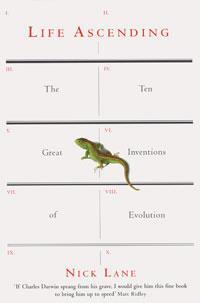Life ascending: the ten great inventions of evolution
Life ascending: the ten great inventions of evolution
Nick Lane
London, UK: Profile Books 2009 | 288pp | ?18.99 (HB)
ISBN 9781861978486
Reviewed by Graham Cairns-Smith

Make no bones about it: this is an excellent book. It is great fun, readable, bubbling over with enthusiasm, and not afraid of controversial, even weird, ideas. The author might have been a bit more afraid in places, but one can’t have it both ways. Choosing to skate on some of the exhilaratingly thin ice at the edges of science pretty well guarantees to annoy some people.
Is evolution an inventor? Its mechanism is indeed very different from the human equivalent but its results are quite similar: it creates those innumerable features of living things that seem to have been designed. This feeling lies at the heart of our informal sense of what life is. Life is clever, ingenious, well adapted - in addition to being part of nature and, oh yes, conforming to the laws of physics and chemistry.
This is not just a matter of language. Products of prolonged natural selection can perform feats that would be absurdly improbable in unevolved systems. For example, (I would say) in consistently creating supplies of particular activated nucleotides devoid of their enantiomers and other related molecules. Or (as Lane explains so well) in the achievement of photosynthesis.
Concerning the very origin of life, I think Lane has put his money on the wrong horse. I mean in the idea that life started from a primitive metabolism. I am of the other ’genetics first’ camp noticing that some kind of hereditary memory is the most essential part of the mechanism of natural selection. Information must pass to offspring otherwise there is no building on past success and no Darwinian evolution.
The ten essays of Life ascending are no doubt best read in sequence, but are also good for dipping into. Hopeless as a bedside book: you’d never sleep.












No comments yet